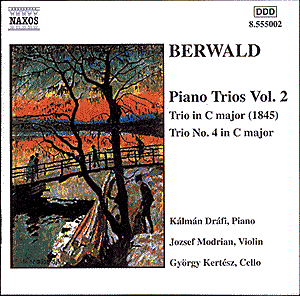 |
Franz BERWALD (1796-1868)
Piano Trios Vol. 2 Piano Trio in C Major, Op. 5 (1845) Piano Trio in E flat Major, [fragment] (1849) Piano Trio in C Major [fragment] (1850) Piano Trio No. 4 in C Major (1853) Rec. Festetich Castle, Budapest, 1991 Crotchet AmazonUK AmazonUS Amazon recommendations |
The Swedish composer Franz Berwald was born in Stockholm into the family of Christian Berwald, a former pupil of Franz Benda of Berlin. He followed the family tradition and was taught the violin by his father. As a member of the court orchestra for 16 years from 1812 he toured as a soloist to Finland and Russia. During this period he had gained a reputation as a small-time composer with a symphony now partly lost. The disjointed way in which Berwald seemed to work on some of his manuscripts, with numerous partial revisions, was to remain with him as a composer. This CD release is interesting in that it allows us to hear fragments of partially-reworked chamber pieces which never saw the light of day.
Berwald wrote most of his chamber music between 1845-1855 in which he composed five piano trios (which include two fragments) along with two piano quartets, and four string quartets. As a violinist and violist himself, Berwald wrote idiomatically for these particular string instruments. With an early weakness in writing for the piano his first experiments in composition brought about a poor balance between strings and piano accompaniment. This, too, had been a problem with more distinguished composers.
The Piano Trio in C Major had been forgotten for over a hundred and thirty years until it was belatedly published in 1981. The first movement in sonata form, Allegro risoluto, opens with an interesting theme in C Major followed by a soothing, chromatic melody. A vigorous transitional passage with descending motif leads into a straight-forward development, and the recapitulation begins with a second subject in the dominant key: the first subject does not reappear. A strong melody begins the Adagio molto which is briefly relieved by a song-like episode. A delicate piano bridging passage leads to a triple-time Scherzo with strong rhythmic momentum. The finale, Presto, is impressive and the strong point of the Trio where a whimsical march in E flat Major supports various introductory ideas.
Fragment in E flat Major: The inclusion of this and a second unpublished manuscript will be of particular interest to musicians interested in following the vocational development of Berwald's style. We are not told how these fragments came to light, nor when; but certainly their abandonment when so much effort had been put into their writing is baffling. With its Largo - Allegro molto -Adagio, the piece is lyrical and expansive, and has a good flow of thematic ideas. As a composition it is particularly well-constructed and with the insertion of the missing cadence could have been completed as a miniature.
Fragment in C Major: Likewise, this fragment is an interesting inclusion. It seems to have come from Berwald's attempt to revise his Trio in C Major. Beginning with the strings in mid-air, the piano provides a transition between the original Adagio and the Scherzo. We are told in Nelson's disc notes that the purpose of Berwald's revision was a search of greater unity with the work, since the revisionary material is in C Major and not in the dominant G Major of the original. The Adagio quasi andante - Presto - Adagio quasi andante form contains a triple-time Scherzo/Presto that is a distinct improvement over the original.
Berwald had set out to complete his revision of the C Major Trio, but instead wrote a new Piano Trio No. 4 in C Major partly based on earlier material. (It seems that inspiration did not come easily to our composer.) The opening theme of the first movement Allegro is taken partly from an ascending theme in the 1845 finale. Following a descending motif in the transition, a G Major second subject is introduced. Here an underlying theme on the cello hints at Borodin. A development of the first subject then leads to a piano solo, which uses an element preceding the transition to the Scherzo in the 1845 composition. The finale, Quasi presto, is a recognisable version of the march-like motif discarded from his 1850 Scherzo.
The musicians are all from Budapest: Dráfi started to play the piano from the age of four, won the major award in the Liszt-Bartók Piano Competition in 1976, and since 1977 has been on the teaching staff of the Liszt Academy. Modrian completed his violin studies in 1985, is concertmaster of the Hungarian State Orchestra and leader of its corresponding chamber orchestra. Kertész won the David Popper Cello competition in 1986 and is a regular chamber music player with recordings here and abroad.
Well written and particularly detailed notes on Berwald and his Trios accompany the CD in English, French and German. Naxos continues to provide its usual high class of engineering of chamber works and chooses a good balance between the instrumentalists.
Although we are not told so, this disc is a reissue of the more expensive Marco Polo CD of the same title: No. 8.223430 presumably now withdrawn.
Raymond Walker